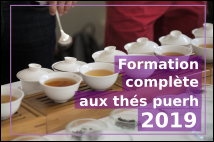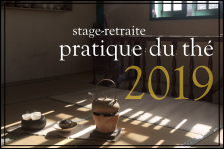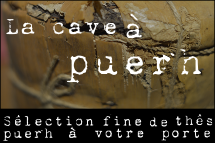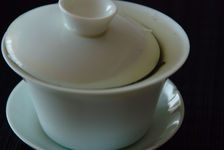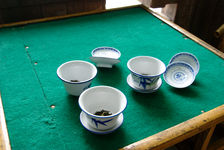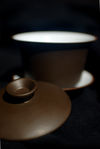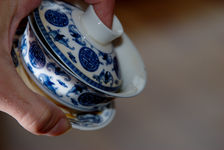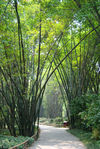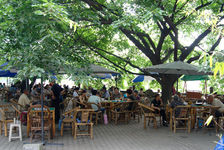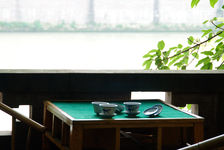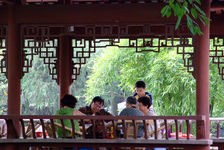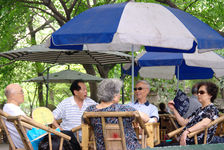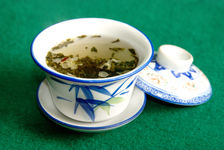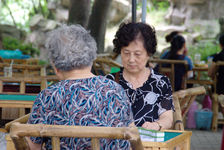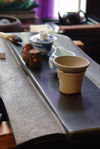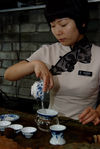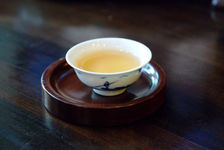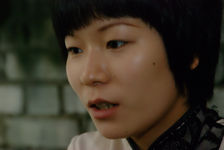 This page is not a real translation but just an automatic translation generated by computer of the original article, written in French language! Its not good... but better than nothing!
This page is not a real translation but just an automatic translation generated by computer of the original article, written in French language! Its not good... but better than nothing!Want to help us do diffuse puerh tea culture in english, by providing a better (or corrected) translation?
Please contact us!

Contrary to what some believe could be in the West, Cha Guan (茶馆), or tea house in China are rarely places propose tasting teas and except where the gung fu is de rigueur and Chinese teahouses are finally terraces reminiscent of French cafes!
Chinese tea, primarily a meeting place and relax
The first written teahouses in China appear to date from the Tang Dynasty (618 to 907) but they have especially their heyday during the Qing Dynasty (1644 to 1911) where we found almost all street corners.
Like what are cafes pubs France or England, tea Chinese foremost meeting places and relaxation. We found it discusses, there is an appointment, we read the newspaper and comment on the news. Before widespread television and newspapers such teahouses were also the favorite place or exchanged and circulated information, news and gossip. Some spend their day and in teahouses, especially the elderly who gather every day before a gaiwan or a portion of mahjong.




- 1.Tea in Yunnan
- 2.Gaiwan undercounter a teahouse in Sichuan
- 3.Szechuan reading a newspaper in a tea outdoors
- 4.Elderly initiating Mahjong part in a tea
Because the Chinese like to gamble and are very playful. It is virtually impossible to get out on the street late afternoon without hearing the sound of dominoes mahjong clashing or see some Chinese occupied playing cards here and there, and the tea is of course place par excellence of the game
If the mahjong (麻将) remains the most popular game, play as many cards, including Dou DiZhu (low 斗地主 owner) very close to the "asshole" much loved in the schoolyard French in the Chinese tea!
The tearooms are generally very economical, there is generally no minimum consumption and not pushing really consumer. For some RMB on a gaiwan and leaves that can be refilled with hot water and hope the Chinese and often spend all afternoon with the same consumption, to discuss or play. It also ranks after a while the gaiwan in a corner or under the table to make room for mahjong or cards. Depending on the location space is composed of a large public hall or often partitioned into small private rooms where we went with his guests.
Usually these places also offer dining. There is often no carte dishes and they are simple and popular, ravioli, noodles or rice along with some vegetables. Teas have their part unexceptional (but what is in France the proportion of cafés serving really good coffee?) While restentant generally still higher teas commonly consumed in the West. Again what matters primarily is to meet and tea is actually only an excuse.
Popular into the '50s the presence of tea in China becoming scarcer and then they are now a much less present in Chinese life than they had at the beginning of the century. Some, however, noted a revival of the traditional tea houses in large cities such as Beijing or Shanghai. Indeed, in parallel with the arrival of Starbucks and other coffee chains in the U.S., tea houses as they existed in the past seem reborn and gain popularity.
He however there's an area where tea houses have never disappeared and has always occupied a special place in people's lives:Sichuan.
Sichuan, culture or tea
Although we still find today teahouses in all regions of China, Sichuan is that they seem to have remained the most active, not only in the landscape but also and especially in the lives of Szechuan . According to the archives of Chengdu, capital of Sichuan, which included 517 city streets in 1909 no fewer than 454 tea houses, nearly a tearoom by street. There is a concentration close enough in 1939 or we count 599 teahouses for 667 streets. Many attribute the strong presence of the Sichuan tea houses two main features of this region, its prosperity and its isolation from the rest of China by the high mountains that surround it.



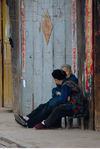
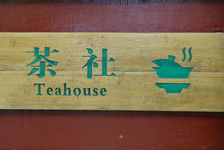
- 1.High mountains in the mist Sichuan
- 2.Small bridge in the mountains of Sichuan
- 3.Village of Sichuan
- 4.Elderly in a village in Sichuan
- 5.Sign indicating the direction a teahouse in Chengdu
Whether in the capital or in small towns the social life of many Szechuan continues to revolve around the tea room, where young and old meet and for some is the third place after their home life and their work. These tea houses always have a certain something in common, simple furniture bamboo (Sichuan is a major producer of bamboo), square tables covered with green baize often to fill play mahjong, decoration where little things unnecessary, sometimes a few plants or calligraphy on the tea. It crosses sometimes local doctors or liseurs future, masseurs vendors, sometimes blind, who offer their services.
Often located inside the corner of an alley, next to a temple or under a covered bridge as the beautiful covered bridge Ya An, there are also many tea rooms open as those lining the quays Chengdu where found under the trees of almost all public parks in the city. These may suggest that the French café terraces are particularly pleasant and can enjoy the pleasure of drinking tea or sharing a Chinese chess in the shade of a tree. Another type of tea finally lies at the heart of performance venues, which are played musical or theatrical performances. Often old and beautiful, these places usually have a central part to devote himself fully to the show, surrounded by various public spaces or private rooms where you can enjoy the moment drinking tea or eating.
Whatever tea, tea is the most common green tea, jasmine tea, Sichuan specialty pervasive and sometimes tea with chrysanthemum flower mix other current China. On the table in addition to the tea, are just a few big gaiwan in china and water or cup or plate, here we drink tea gay wan cha Szechuan fashion.
Gay wan cha or how we drink tea in Sichuan
Sichuan tea is generally consumed Gay Cha Wan and not gung fu cha . It is said that the gaiwan, literally "bowl with lid" was invented during the Jian Zhang (780 to 783) during the Tang Dynasty by the governor's daughter Cui Ning who was managing Sichuan. Finding the cup too hot to hold in the hand, it would have drawn a small cup saucer marrying stably to lift without burning. Later was added the cover, to keep the sheets suspended in the cup.
These three parts called "San Pao Tai" are held simultaneously in Sichuan and the tea is drunk directly gaiwan in there with his lips, using cover to avoid the tea leaves out of the cup. This mode of infusion teas naturally favors longer, and perfectly suited to the Sichuan tea such as jasmine tea.
Visit two teahouses in Chengdu
Sometimes called Rongcheng (the city of hibiscus), Chengdu is the capital of Sichuan. This "small" Chinese city of about 5 million people in a very old history and is already playing an important political role from the period known as the Spring and Autumn (from 770-475 BC).

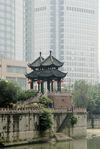
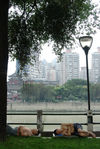
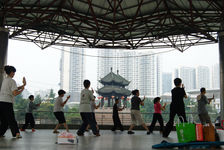
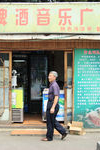
- 1.former Chengdu Bus
- 2.Chengdu traces between the past and modernity
- 3.Docks Chengdu
- 4.Tai Qi in the streets of Chengdu
- 5.Small bar on the banks of Chengdu
There are of course a multitude of tea, the smallest and popular tearoom neighborhood tea house luxury and fame, and these institutions are very popular for city dwellers. Apart from the multitude of small teashops and sometimes closed at the heart of the old town, numerous Cha Guan are outside along the canals that cross the city or in its various public parks. One of them particularly pleasant is that which takes place within the park Wang Jiang Lou.
Cha Guan Wang Jiang Lou (望江 楼 River Viewing Pavilion Park)
The park is famous for its bamboo. More than 150 varieties of bamboo are grown from the smallest to the most gigantic and parts of the park are reminiscent of bamboo forests of some gung fu movies. The tea room is located on the edge of the canal and is very representative of Cha Guan popular city.
Entry is free and you have to move to get his gaiwan tea and a large thermos of water. Various major classical Chinese teas are offered, as well as diverse and varied snacks, sunflower seeds (Gua Ze), etc ... Large umbrellas, square tables covered with green baize, comfortable bamboo chairs. It consumes its own tea or tea offered, there picnic there reading his newspaper in the sun or there bet money mahjong.
A lunchtime appear on all tables trays and trays of food from the bag or purchased locally where we prepare a daily basic, then goes back to Mahjong while drinking jasmine tea . Population in its majority age but sometimes we came across some young people. Between the canal and the surrounding park, the place is very nice and quiet, tea and decent food.
Yuqing Art Collection Club (余庆 会馆)
In a radically different style is the Yuqing Club Art Collection at the center of the city. This luxurious and reputable establishment, whose name was translated into English as "club" is as a social meeting one Hue Guan (会馆). Founded in 2008 shortly after the earthquake that devastated Sichuan, a wealthy owner of passionate tea and jade, this place that caters to the wealthy rather have another social impact since nearly 80% of its revenues are invested in charity. It echoes a phrase book Yi said that life must be made of an accumulation of good deeds.
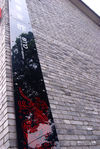
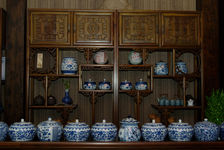
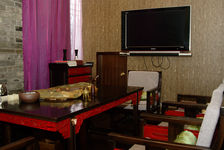
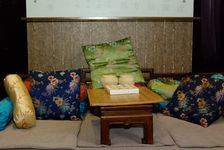
- 1.Yuqing Club Art Collection
- 2.Some teas Yuqing Club Art Collection
- 3.Private rooms of Yuqing Club Art Collection
- 4.Private rooms of Yuqing Art Collection Club
In addition to the home where a large tea table allows tastings, there are no public spaces dedicated to tea, but like many Chinese institutions, several small private rooms that can be occupied with some friends. And tastefully decorated in a classic style there are a large tea table, chairs, sofas, television. Here is another customer that is expected, mahjong, cards and gambling give way to Chinese chess and the game of go.
The Art Collection Yuqing Club has a large map of quality tea. Some fifty references it contains the six major types of tea from China and Taiwan. The price for a gaiwan are quite high and teas vary widely, from 50 RMB () or Long Jing Bai Hao Yin Zhen to 1088 RMB () for Puerh Xiaguan Xiao Fa 1983. The tea I've tasted a Song Zhang was particularly delicate and complex. This roasted oolong Wu Yi was remarkable antinomy den taste bitter and astringent in the mouth clearly and hui gan (aftertaste) a rich roundness and excessive sweetness.
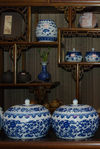
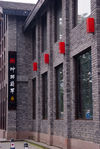
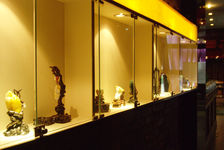
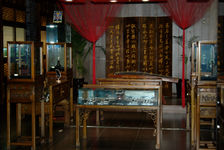
- 1.Yuqing Art Collection Club
- 2.Art Collection sale of Yuqing Club Art Collection
- 4.Book of Long Ying Tai
But this property does not suggest that tea. Founded by an avid tea but also jade, another room on the ground floor sells a large collection of art and jade jewelry prices which end at the height of beauty. Finally, the first floor is regularly organized in a large public space various cultural events such as meetings of personalities, lectures, or auctions of works. Last week there was a meeting organized around Long Ying Tai (龙应台) Taiwanese famous author whose book censored in China, in search of his past on the continent has become a great success.

